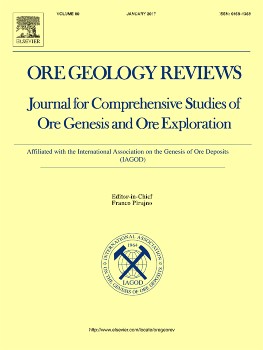
Origin and geochemical evolution from ferrallitized clays to karst bauxite
Four outcrops of Lower Cretaceous (Barremian) karst bauxites located in Teruel (NE Spain) were analysed. The deposits show a heterogeneous-chaotic lithostructure consisting of pisolitic bauxite blocks embedded in lateritic red clays filling karst cavities. The research has focused on the geochemical study of major, minor, and trace elements (including some critical to industry) of both the bauxites and clays. The objective was to investigate the bauxite precursor material and to characterize the system’s geochemical evolution. Geochemical analyses were carried out by inductively-coupled plasma optical emission and mass spectroscopy. An absolute weathering index has been calculated to estimate element mobility, assuming Ti as an immobile element and the Upper Continental Crust (UCC) as parent material. Further, selected samples were observed by field emission scanning electron microscopy. The data indicate that both the bauxites and red clays originated by intense chemical weathering from more mafic argillaceous sediments than the UCC. Ongoing weathering caused the bauxitization of the upper parts of the original profile, preventing the lower parts from being bauxitized, thus producing the ferrallitized clays underlying the pisolitic bauxites. Subsequent karst reactivation gave rise to the current lithostructure. Ferrallitization is related to Fe, Sc, and V enrichment. On the other hand, although bauxites are relatively enriched in some elements compared to clays, the more intense chemical weathering associated with bauxitization led to chemical homogenization and widespread element depletion. During the bauxitization, Al, Ti, Zr, Cr, and probably Hf and the critical element Nb behaved as more immobile elements in the system. Bauxitization also enhanced homogenization and depletion of the REE, which is more pronounced for the LREE. HREE trends seem to be partly related to the concentration of Ti oxides in the bauxites, whereas P-bearing phases, more frequent in the clays, control the LREE. Subsequent to bauxitization, partial kaolinization of the bauxite took place related to the circulation of acid solutions that also caused the karst reactivation. These late processes caused some Al depletion in the bauxites and enhanced Fe loss together with V and, to a lesser extent, Ge
source: https://www.sciencedirect.com